OWC Mercury Extreme SSD - First Look at a 50GB SandForce Drive
by Anand Lal Shimpi on February 26, 2010 12:00 AM EST- Posted in
- Storage
Overall System Performance using PCMark Vantage
Next up is PCMark Vantage, another system-wide performance suite. For those of you who aren’t familiar with PCMark Vantage, it ends up being the most real-world-like hard drive test I can come up with. It runs things like application launches, file searches, web browsing, contacts searching, video playback, photo editing and other completely mundane but real-world tasks. I’ve described the benchmark in great detail before but if you’d like to read up on what it does in particular, take a look at Futuremark’s whitepaper on the benchmark; it’s not perfect, but it’s good enough to be a member of a comprehensive storage benchmark suite. Any performance impacts here would most likely be reflected in the real world.
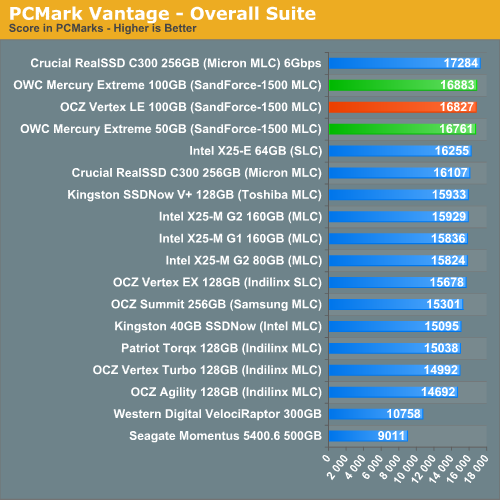
PCMark Vantage mostly echoes what you'd expect based on our data thus far. There's no real performance difference, in the real world, between the 100GB and 50GB SandForce SF-1500 MLC drives. It's only in the HDD specific test that we see any evidence of a slower drive, and even then the drop isn't that great.
The memories suite includes a test involving importing pictures into Windows Photo Gallery and editing them, a fairly benign task that easily falls into the category of being very influenced by disk performance.

The TV and Movies tests focus on on video transcoding which is mostly CPU bound, but one of the tests involves Windows Media Center which tends to be disk bound.
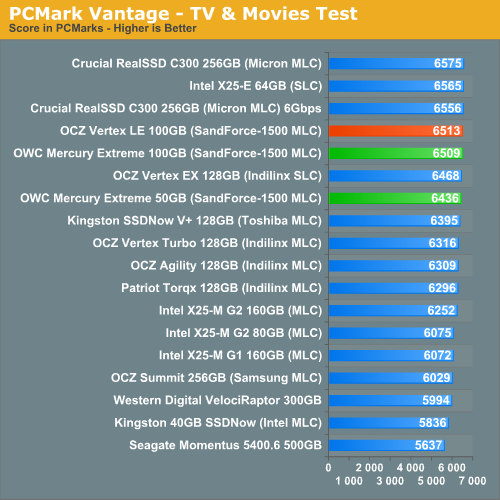
The gaming tests are very well suited to SSDs since they spend a good portion of their time focusing on reading textures and loading level data. All of the SSDs dominate here, but as you'll see later on in my gaming tests the benefits of an SSD really vary depending on the game. Take these results as a best case scenario of what can happen, not the norm.
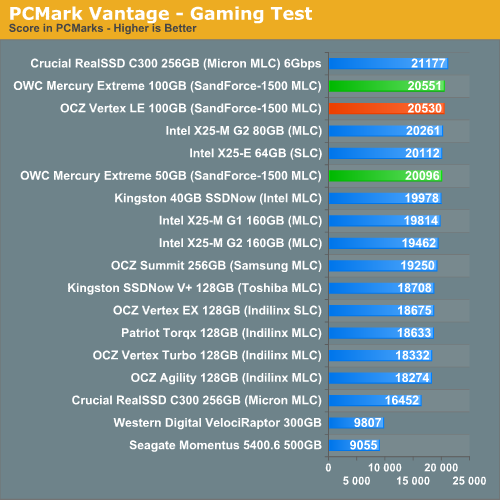
In the Music suite the main test is a multitasking scenario: the test simulates surfing the web in IE7, transcoding an audio file and adding music to Windows Media Player (the most disk intensive portion of the test).
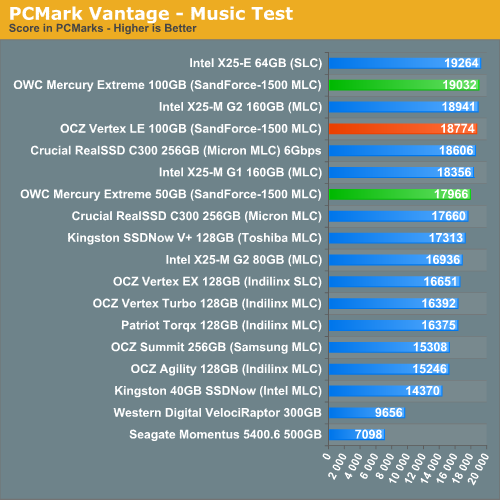
The Communications suite is made up of two tests, both involving light multitasking. The first test simulates data encryption/decryption while running message rules in Windows Mail. The second test simulates web surfing (including opening/closing tabs) in IE7, data decryption and running Windows Defender.

I love PCMark's Productivity test; in this test there are four tasks going on at once, searching through Windows contacts, searching through Windows Mail, browsing multiple webpages in IE7 and loading applications. This is as real world of a scenario as you get and it happens to be representative of one of the most frustrating HDD usage models - trying to do multiple things at once. There's nothing more annoying than trying to launch a simple application while you're doing other things in the background and have the load take forever.
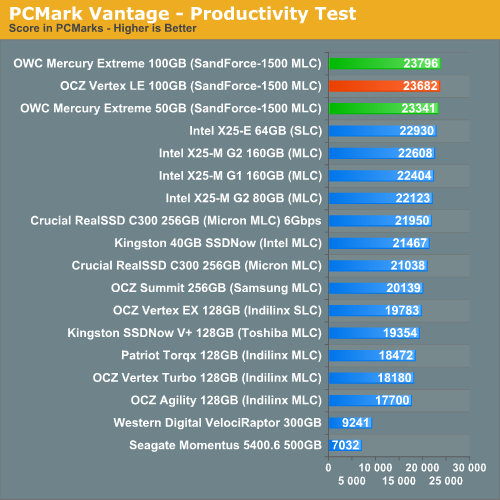
The final PCMark Vantage suite is HDD specific and this is where you'll see the biggest differences between the drives:











74 Comments
View All Comments
Anand Lal Shimpi - Friday, February 26, 2010 - link
I suspect within a month :)fic2 - Friday, February 26, 2010 - link
My calculator says that $229.99/50G = $4.5998 not $3.59. I think you divided by 64G instead of 50G.Anand Lal Shimpi - Friday, February 26, 2010 - link
I did divide by 64GB :) I wanted to show the total cost per GB of NAND you were paying for. It's still used, even if it's not being exposed to your OS. It's also why I said that the situation gets worse when you look at available user space.Take care,
Annad
iwodo - Friday, February 26, 2010 - link
Thanks for clearing up. I think you should mention the drive have 64GB ( I dont think it is mentioned anywhere )Anand Lal Shimpi - Saturday, February 27, 2010 - link
Second paragraph after the last table on the front page, I mention that it has 64GB of MLC NAND :)Take care,
Anand
fic2 - Friday, February 26, 2010 - link
That is what I figured, but I still think it is strange - it is advertised as a 50G SSD so that is what I think the $/G should be based on. Kind of like saying a car is a 5 wheel vehicle because you have an unused spare in the trunk.ratbert1 - Friday, February 26, 2010 - link
...are there any reviews forthcoming on the Corsair Reactor or Nova drives? I heard the Reactors are out, don't know about the Nova.Mr Alpha - Friday, February 26, 2010 - link
Can I ask: what is the latest build of IOMeter?Anand Lal Shimpi - Friday, February 26, 2010 - link
6-22-2008 build :)jimhsu - Sunday, February 28, 2010 - link
Right, you're using IOmeter. It shouldn't be hard to include maximum IO latency as a performance figure seeing as you already did so in the earlier SSD articles, i.e. http://www.anandtech.com/cpuchipsets/intel/showdoc...">http://www.anandtech.com/cpuchipsets/intel/showdoc...